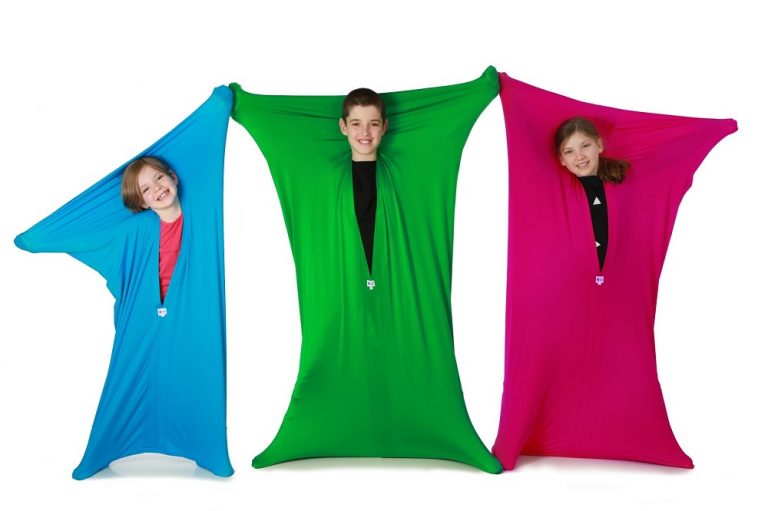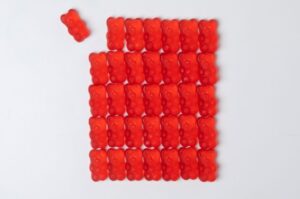
A hyperactive child who is constantly jumping and bouncing off the walls? Do they enjoy crashing into everything? Maybe they’re clumsy? Then a sensory body sock could be a great sensory activity to calm your kid and even reduce clumsiness!
What is a Sensory Sock?
A sensory sock is a sensory instrument or toy that resembles a pillowcase, except the opening has a split in the centre, and the fabric is elastic. The sensory body sock is made for children to climb into and stretch out their arms and legs by providing a lot of resistance to the fabric. Children frequently prefer to stick their heads in as well. This resistance stimulates their sensory system by providing proprioceptive input.
Proprioception is one of our eight senses, with receptors on our joints and muscles. When such receptors are squeezed or engaged through pressure, they convey messages to the brain. Many sensory seekers enjoy proprioceptive stimulation, which they obtain when they climb, leap, sprint, squeeze into a small space, or hug someone. The sensory body sock is a direct method of providing the proprioceptive input that seekers want.
Some children that seek proprioceptive input do not seem to process it well. A proprioceptive sense exists to provide us with body awareness. Body awareness is the ability to recognize where our arm or leg is without having to look. It allows us to stroll through a room full of furniture without tripping over anything.
How to Use a Sensory Sock?
Now comes the exciting part. You’ve measured your children, purchased or manufactured your body sock, learned why this sensory sock benefits your children, and now you’re ready to play!! Here are some of our favourite activities for using a body sock with children. But don’t forget to let those small ones loose to invent their games!
When it comes to sensory input and motor skill development, children are frequently the best inventors!
- Experiment with various movements and positions in the body sock.
- While wearing the body sock, do some yoga positions.
- Combine the body sock with different props!
- Use the body sock as a prop in other games.
When to use a Sensory Sock for your kid?
Sensory body socks are worn at various times during the day. Ideally, your child should have access to it and be able to use it anytime they want. However, you may explore delivering proprioceptive input when your child is struggling to sit still or appears to be seeking it, which is the core of a sensory diet.
If your child struggles in school due to hyperactivity, give them 10 minutes before school to use the body sock. Or do they have a lot of energy when they arrive home? Give them after school.
You May Like: What is Lychee Water and its Benefit
If you believe your child would benefit from utilizing a sensory body sock at school, then consult with the teacher. It could be an excellent method to include a movement break. Body socks fold up small enough to fit in most backpacks. They also help some children relax before falling asleep at Night, so incorporating one into your bedtime routine may be beneficial.
Therapeutic Uses for a Sensory Sock
Self-Regulation-The sensory sock’s proprioceptive input gives deep pressure to the child’s entire body. This input is relaxing and can help regulate the child’s arousal level.
Endurance-Because the sensory sock is resistant, the youngster will naturally work on his strength and endurance while participating in activities while wearing the sock. While wearing the body sock, you can do various hobbies such as board games, reading, or yoga practices.
Body Awareness-The sensory sock’s input promotes body awareness by providing the child with additional feedback about where their body parts are about one in the sensory sock’s. While your child is wearing the body sock, set up an obstacle course for him; he can crawl over pillows and walk across a “tightrope.”
How to Choose the Right Size of Sensory Body Sock for your Kid
The sensory body sock must fit your child to get the maximum benefit out of it.
All kids can wear different sizes, so they don’t seem like they’re wearing a giant hoodie or blanket.
Make sure you know your child’s size before purchasing a body sock. So that when it arrives, there will be no problems using it. Mostly the size is incorrect, and your child gets injured, which no parent wants to happen. As a result, always ensure that your child’s body sock fits. You want your child to fits in because only then will they be able to push the cloth and experience the sensation that your child needs.
You May Like: How To Use Niacinamide Serum
Precautions and Risks:
• Because the material is slick, standing in a body sock increases the child’s chance of slipping.
• Children can choose whether to put their heads inside or outside the sock. Children who prefer to put their heads inside the body sock are more likely to fall because they cannot see as well.
• When a child wears a sensory sock, monitor closely.
• Make sure there are no obstacles in the child’s path.
Conclusion:
Sensory socks are therapeutically good for any child; many parents do not see the need for them, but they are successful. It stimulates one of the eight sensory receptors, allowing your child to be active while simultaneously having fun, especially for hyperactive children.
Image Source: sistersensory.com.au







